Analysis of Coca-Cola's Macro Environment: Political, Economic, etc.
VerifiedAdded on 2023/04/23
|9
|2931
|128
Report
AI Summary
This report provides a comprehensive macro-environmental analysis of The Coca-Cola Company, examining the political, economic, socio-cultural, and technological factors influencing its operations. The analysis delves into how government policies, trade regulations, and political stability impact Coca-Cola's global presence and manufacturing processes, including regulatory oversight by the Food and Drug Administration (FDA). Economic factors such as exchange rates, economic growth, and consumer income are assessed for their effects on market entry, pricing strategies, and consumer demand across the company's extensive international markets. Socio-cultural dimensions, including cultural norms, demographic trends, and health consciousness, are considered in relation to product adaptation and marketing strategies, such as the introduction of product variations like Diet Coke and Coca-Cola Zero to cater to diverse consumer preferences and behaviors. Furthermore, the report explores the impact of technological advancements, including automation, social media, and online advertising, on Coca-Cola's production efficiency, marketing campaigns, and overall market competitiveness, highlighting the significance of innovation in a rapidly evolving business environment. The report underscores the importance of adapting to changing consumer preferences and technological advancements to maintain a competitive edge in the global market.
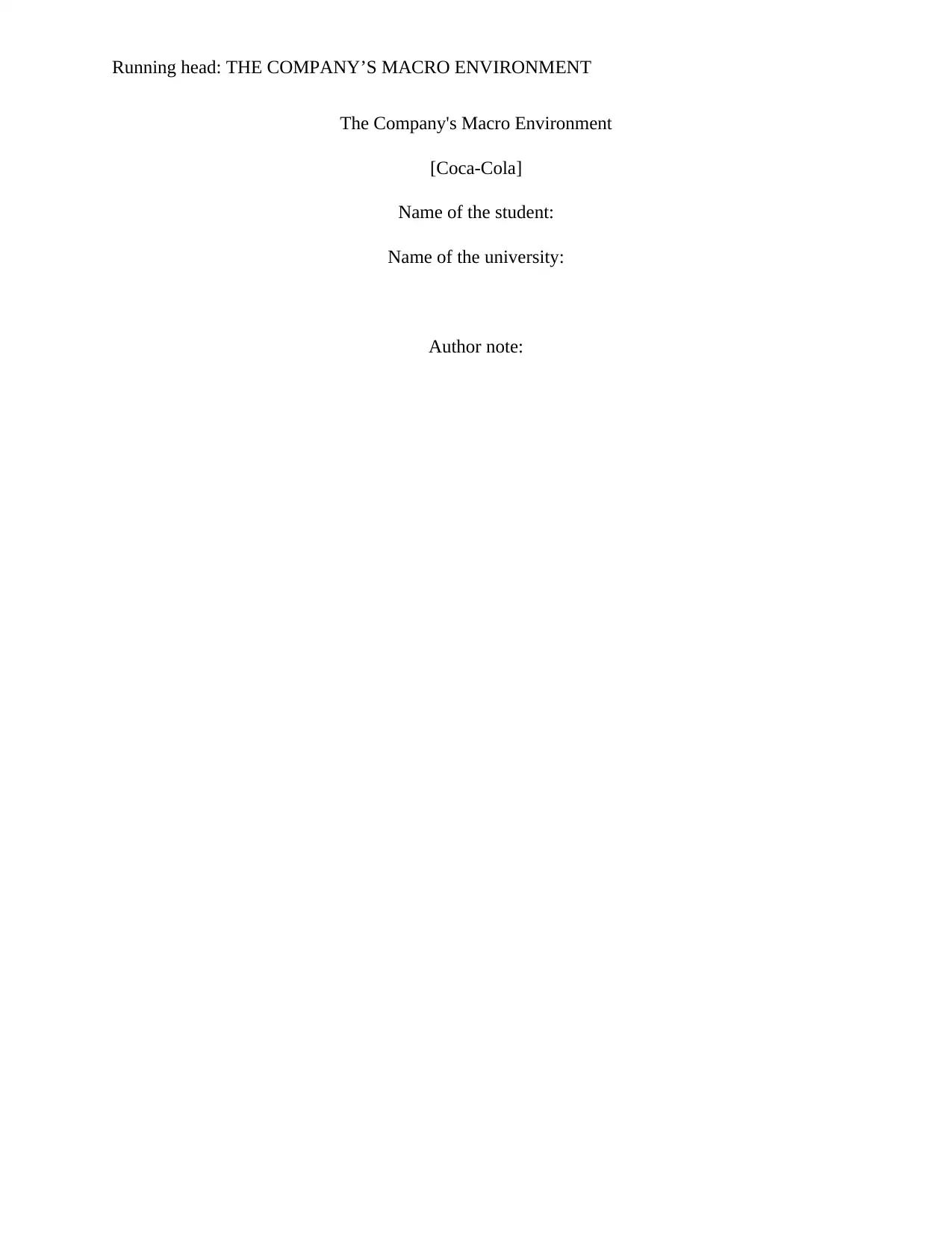
Running head: THE COMPANY’S MACRO ENVIRONMENT
The Company's Macro Environment
[Coca-Cola]
Name of the student:
Name of the university:
Author note:
The Company's Macro Environment
[Coca-Cola]
Name of the student:
Name of the university:
Author note:
Paraphrase This Document
Need a fresh take? Get an instant paraphrase of this document with our AI Paraphraser
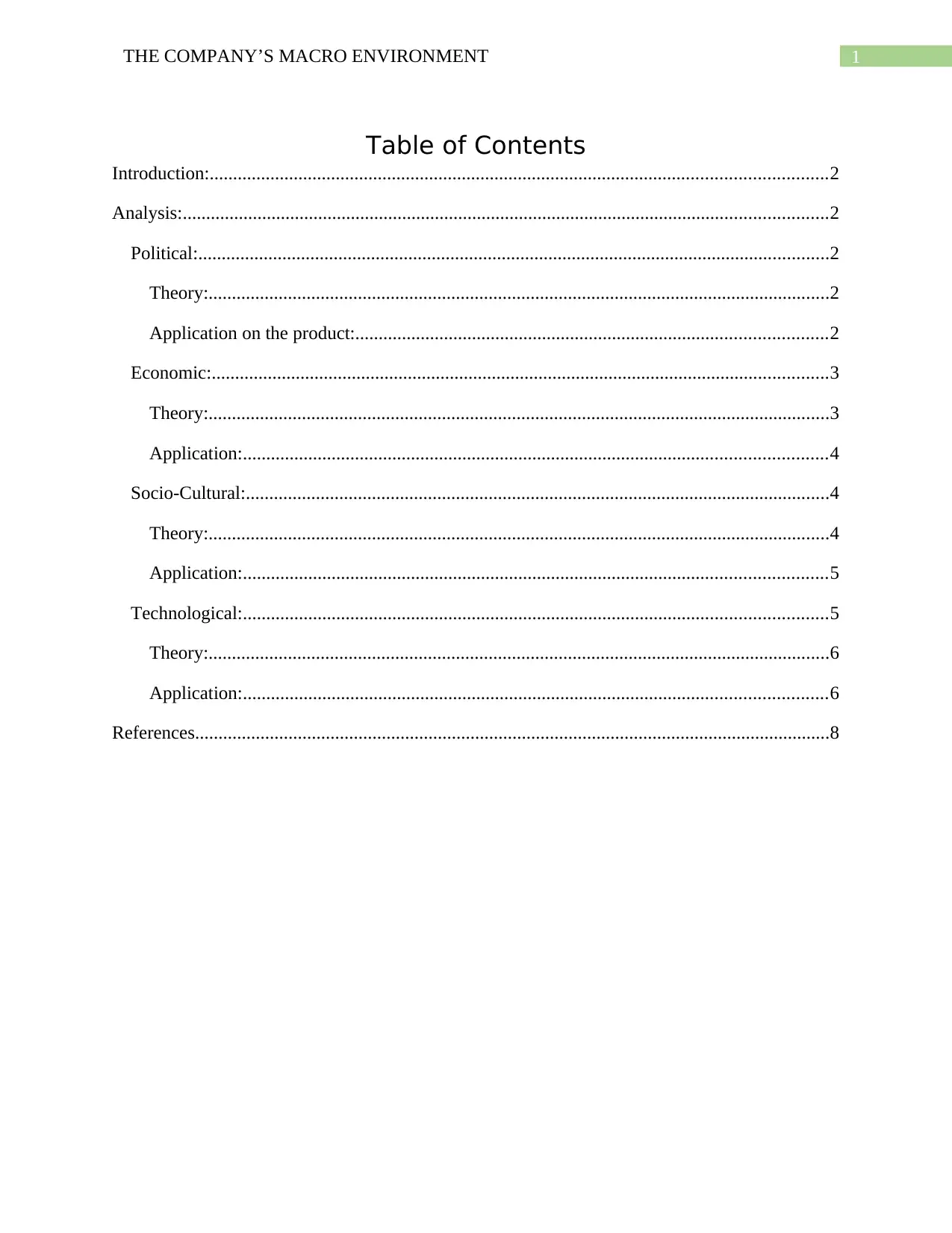
1THE COMPANY’S MACRO ENVIRONMENT
Table of Contents
Introduction:....................................................................................................................................2
Analysis:..........................................................................................................................................2
Political:.......................................................................................................................................2
Theory:.....................................................................................................................................2
Application on the product:.....................................................................................................2
Economic:....................................................................................................................................3
Theory:.....................................................................................................................................3
Application:.............................................................................................................................4
Socio-Cultural:.............................................................................................................................4
Theory:.....................................................................................................................................4
Application:.............................................................................................................................5
Technological:.............................................................................................................................5
Theory:.....................................................................................................................................6
Application:.............................................................................................................................6
References........................................................................................................................................8
Table of Contents
Introduction:....................................................................................................................................2
Analysis:..........................................................................................................................................2
Political:.......................................................................................................................................2
Theory:.....................................................................................................................................2
Application on the product:.....................................................................................................2
Economic:....................................................................................................................................3
Theory:.....................................................................................................................................3
Application:.............................................................................................................................4
Socio-Cultural:.............................................................................................................................4
Theory:.....................................................................................................................................4
Application:.............................................................................................................................5
Technological:.............................................................................................................................5
Theory:.....................................................................................................................................6
Application:.............................................................................................................................6
References........................................................................................................................................8
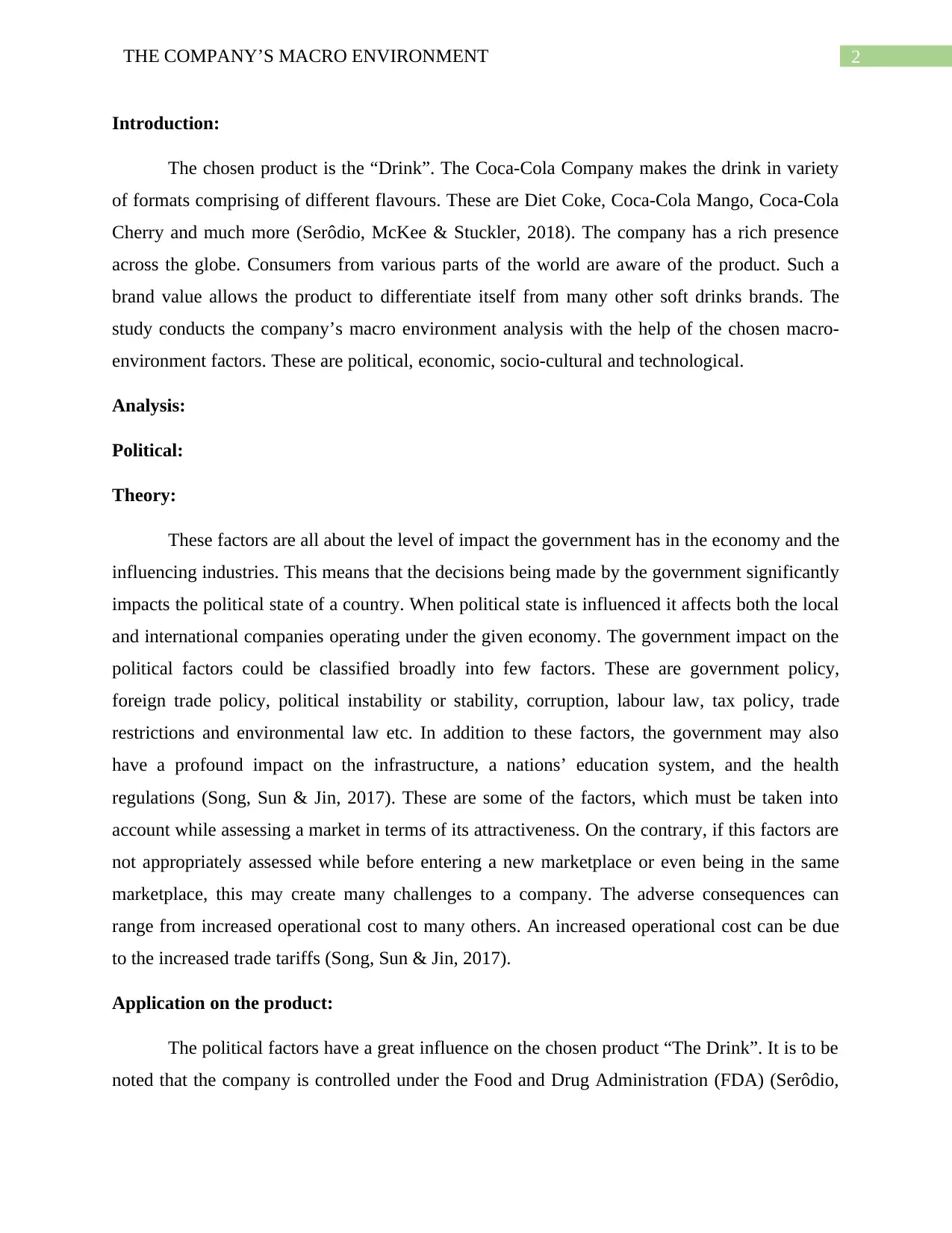
2THE COMPANY’S MACRO ENVIRONMENT
Introduction:
The chosen product is the “Drink”. The Coca-Cola Company makes the drink in variety
of formats comprising of different flavours. These are Diet Coke, Coca-Cola Mango, Coca-Cola
Cherry and much more (Serôdio, McKee & Stuckler, 2018). The company has a rich presence
across the globe. Consumers from various parts of the world are aware of the product. Such a
brand value allows the product to differentiate itself from many other soft drinks brands. The
study conducts the company’s macro environment analysis with the help of the chosen macro-
environment factors. These are political, economic, socio-cultural and technological.
Analysis:
Political:
Theory:
These factors are all about the level of impact the government has in the economy and the
influencing industries. This means that the decisions being made by the government significantly
impacts the political state of a country. When political state is influenced it affects both the local
and international companies operating under the given economy. The government impact on the
political factors could be classified broadly into few factors. These are government policy,
foreign trade policy, political instability or stability, corruption, labour law, tax policy, trade
restrictions and environmental law etc. In addition to these factors, the government may also
have a profound impact on the infrastructure, a nations’ education system, and the health
regulations (Song, Sun & Jin, 2017). These are some of the factors, which must be taken into
account while assessing a market in terms of its attractiveness. On the contrary, if this factors are
not appropriately assessed while before entering a new marketplace or even being in the same
marketplace, this may create many challenges to a company. The adverse consequences can
range from increased operational cost to many others. An increased operational cost can be due
to the increased trade tariffs (Song, Sun & Jin, 2017).
Application on the product:
The political factors have a great influence on the chosen product “The Drink”. It is to be
noted that the company is controlled under the Food and Drug Administration (FDA) (Serôdio,
Introduction:
The chosen product is the “Drink”. The Coca-Cola Company makes the drink in variety
of formats comprising of different flavours. These are Diet Coke, Coca-Cola Mango, Coca-Cola
Cherry and much more (Serôdio, McKee & Stuckler, 2018). The company has a rich presence
across the globe. Consumers from various parts of the world are aware of the product. Such a
brand value allows the product to differentiate itself from many other soft drinks brands. The
study conducts the company’s macro environment analysis with the help of the chosen macro-
environment factors. These are political, economic, socio-cultural and technological.
Analysis:
Political:
Theory:
These factors are all about the level of impact the government has in the economy and the
influencing industries. This means that the decisions being made by the government significantly
impacts the political state of a country. When political state is influenced it affects both the local
and international companies operating under the given economy. The government impact on the
political factors could be classified broadly into few factors. These are government policy,
foreign trade policy, political instability or stability, corruption, labour law, tax policy, trade
restrictions and environmental law etc. In addition to these factors, the government may also
have a profound impact on the infrastructure, a nations’ education system, and the health
regulations (Song, Sun & Jin, 2017). These are some of the factors, which must be taken into
account while assessing a market in terms of its attractiveness. On the contrary, if this factors are
not appropriately assessed while before entering a new marketplace or even being in the same
marketplace, this may create many challenges to a company. The adverse consequences can
range from increased operational cost to many others. An increased operational cost can be due
to the increased trade tariffs (Song, Sun & Jin, 2017).
Application on the product:
The political factors have a great influence on the chosen product “The Drink”. It is to be
noted that the company is controlled under the Food and Drug Administration (FDA) (Serôdio,
⊘ This is a preview!⊘
Do you want full access?
Subscribe today to unlock all pages.

Trusted by 1+ million students worldwide
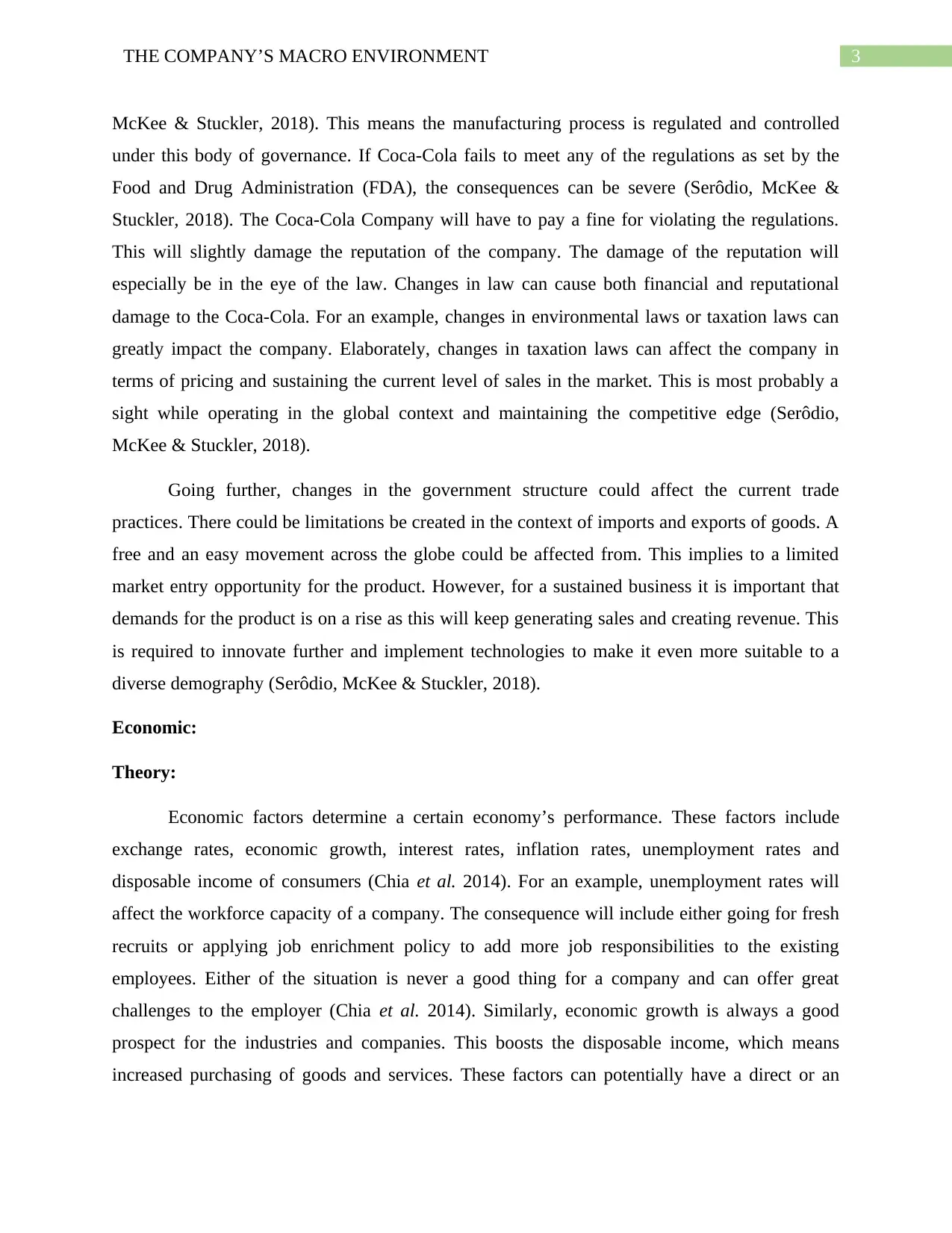
3THE COMPANY’S MACRO ENVIRONMENT
McKee & Stuckler, 2018). This means the manufacturing process is regulated and controlled
under this body of governance. If Coca-Cola fails to meet any of the regulations as set by the
Food and Drug Administration (FDA), the consequences can be severe (Serôdio, McKee &
Stuckler, 2018). The Coca-Cola Company will have to pay a fine for violating the regulations.
This will slightly damage the reputation of the company. The damage of the reputation will
especially be in the eye of the law. Changes in law can cause both financial and reputational
damage to the Coca-Cola. For an example, changes in environmental laws or taxation laws can
greatly impact the company. Elaborately, changes in taxation laws can affect the company in
terms of pricing and sustaining the current level of sales in the market. This is most probably a
sight while operating in the global context and maintaining the competitive edge (Serôdio,
McKee & Stuckler, 2018).
Going further, changes in the government structure could affect the current trade
practices. There could be limitations be created in the context of imports and exports of goods. A
free and an easy movement across the globe could be affected from. This implies to a limited
market entry opportunity for the product. However, for a sustained business it is important that
demands for the product is on a rise as this will keep generating sales and creating revenue. This
is required to innovate further and implement technologies to make it even more suitable to a
diverse demography (Serôdio, McKee & Stuckler, 2018).
Economic:
Theory:
Economic factors determine a certain economy’s performance. These factors include
exchange rates, economic growth, interest rates, inflation rates, unemployment rates and
disposable income of consumers (Chia et al. 2014). For an example, unemployment rates will
affect the workforce capacity of a company. The consequence will include either going for fresh
recruits or applying job enrichment policy to add more job responsibilities to the existing
employees. Either of the situation is never a good thing for a company and can offer great
challenges to the employer (Chia et al. 2014). Similarly, economic growth is always a good
prospect for the industries and companies. This boosts the disposable income, which means
increased purchasing of goods and services. These factors can potentially have a direct or an
McKee & Stuckler, 2018). This means the manufacturing process is regulated and controlled
under this body of governance. If Coca-Cola fails to meet any of the regulations as set by the
Food and Drug Administration (FDA), the consequences can be severe (Serôdio, McKee &
Stuckler, 2018). The Coca-Cola Company will have to pay a fine for violating the regulations.
This will slightly damage the reputation of the company. The damage of the reputation will
especially be in the eye of the law. Changes in law can cause both financial and reputational
damage to the Coca-Cola. For an example, changes in environmental laws or taxation laws can
greatly impact the company. Elaborately, changes in taxation laws can affect the company in
terms of pricing and sustaining the current level of sales in the market. This is most probably a
sight while operating in the global context and maintaining the competitive edge (Serôdio,
McKee & Stuckler, 2018).
Going further, changes in the government structure could affect the current trade
practices. There could be limitations be created in the context of imports and exports of goods. A
free and an easy movement across the globe could be affected from. This implies to a limited
market entry opportunity for the product. However, for a sustained business it is important that
demands for the product is on a rise as this will keep generating sales and creating revenue. This
is required to innovate further and implement technologies to make it even more suitable to a
diverse demography (Serôdio, McKee & Stuckler, 2018).
Economic:
Theory:
Economic factors determine a certain economy’s performance. These factors include
exchange rates, economic growth, interest rates, inflation rates, unemployment rates and
disposable income of consumers (Chia et al. 2014). For an example, unemployment rates will
affect the workforce capacity of a company. The consequence will include either going for fresh
recruits or applying job enrichment policy to add more job responsibilities to the existing
employees. Either of the situation is never a good thing for a company and can offer great
challenges to the employer (Chia et al. 2014). Similarly, economic growth is always a good
prospect for the industries and companies. This boosts the disposable income, which means
increased purchasing of goods and services. These factors can potentially have a direct or an
Paraphrase This Document
Need a fresh take? Get an instant paraphrase of this document with our AI Paraphraser
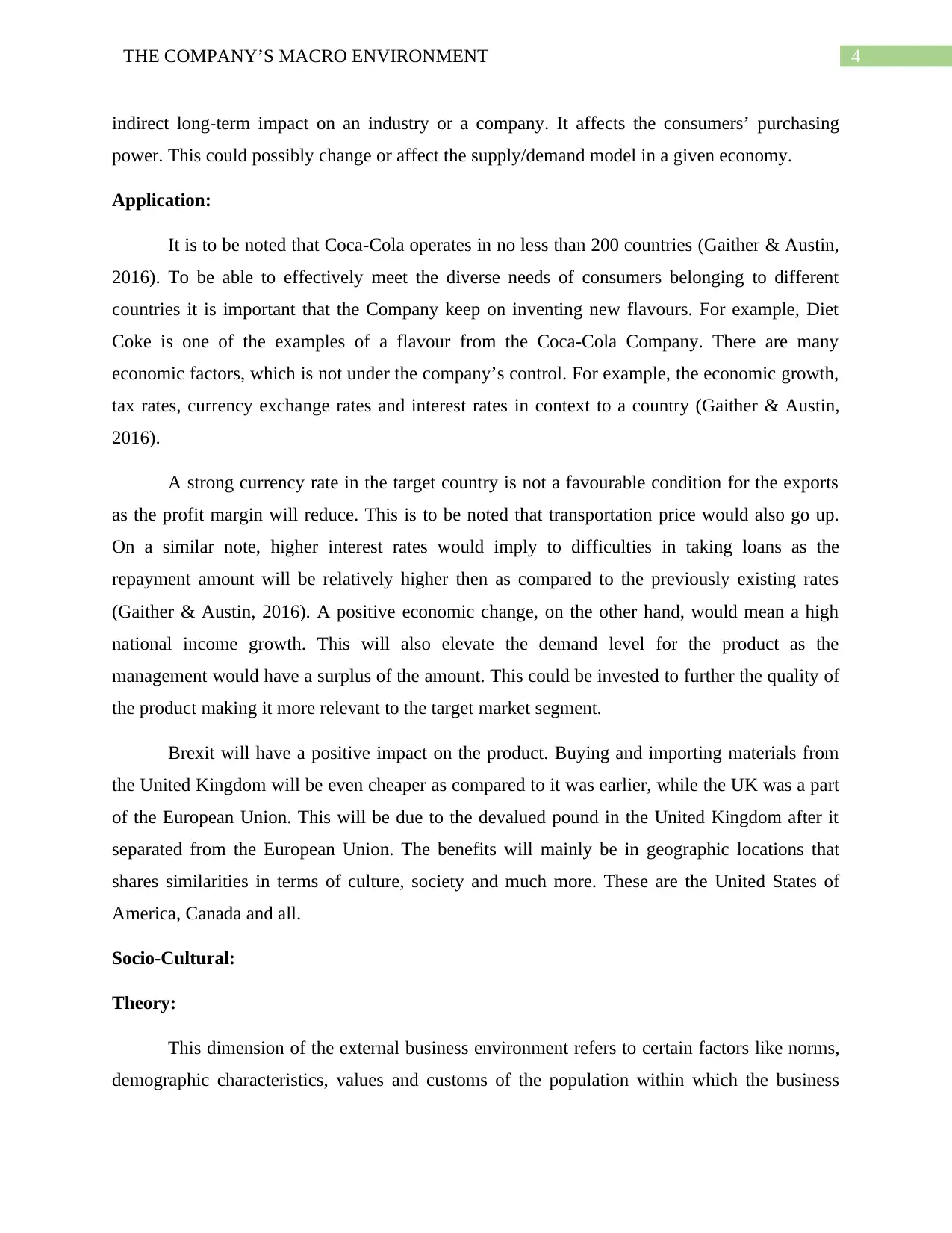
4THE COMPANY’S MACRO ENVIRONMENT
indirect long-term impact on an industry or a company. It affects the consumers’ purchasing
power. This could possibly change or affect the supply/demand model in a given economy.
Application:
It is to be noted that Coca-Cola operates in no less than 200 countries (Gaither & Austin,
2016). To be able to effectively meet the diverse needs of consumers belonging to different
countries it is important that the Company keep on inventing new flavours. For example, Diet
Coke is one of the examples of a flavour from the Coca-Cola Company. There are many
economic factors, which is not under the company’s control. For example, the economic growth,
tax rates, currency exchange rates and interest rates in context to a country (Gaither & Austin,
2016).
A strong currency rate in the target country is not a favourable condition for the exports
as the profit margin will reduce. This is to be noted that transportation price would also go up.
On a similar note, higher interest rates would imply to difficulties in taking loans as the
repayment amount will be relatively higher then as compared to the previously existing rates
(Gaither & Austin, 2016). A positive economic change, on the other hand, would mean a high
national income growth. This will also elevate the demand level for the product as the
management would have a surplus of the amount. This could be invested to further the quality of
the product making it more relevant to the target market segment.
Brexit will have a positive impact on the product. Buying and importing materials from
the United Kingdom will be even cheaper as compared to it was earlier, while the UK was a part
of the European Union. This will be due to the devalued pound in the United Kingdom after it
separated from the European Union. The benefits will mainly be in geographic locations that
shares similarities in terms of culture, society and much more. These are the United States of
America, Canada and all.
Socio-Cultural:
Theory:
This dimension of the external business environment refers to certain factors like norms,
demographic characteristics, values and customs of the population within which the business
indirect long-term impact on an industry or a company. It affects the consumers’ purchasing
power. This could possibly change or affect the supply/demand model in a given economy.
Application:
It is to be noted that Coca-Cola operates in no less than 200 countries (Gaither & Austin,
2016). To be able to effectively meet the diverse needs of consumers belonging to different
countries it is important that the Company keep on inventing new flavours. For example, Diet
Coke is one of the examples of a flavour from the Coca-Cola Company. There are many
economic factors, which is not under the company’s control. For example, the economic growth,
tax rates, currency exchange rates and interest rates in context to a country (Gaither & Austin,
2016).
A strong currency rate in the target country is not a favourable condition for the exports
as the profit margin will reduce. This is to be noted that transportation price would also go up.
On a similar note, higher interest rates would imply to difficulties in taking loans as the
repayment amount will be relatively higher then as compared to the previously existing rates
(Gaither & Austin, 2016). A positive economic change, on the other hand, would mean a high
national income growth. This will also elevate the demand level for the product as the
management would have a surplus of the amount. This could be invested to further the quality of
the product making it more relevant to the target market segment.
Brexit will have a positive impact on the product. Buying and importing materials from
the United Kingdom will be even cheaper as compared to it was earlier, while the UK was a part
of the European Union. This will be due to the devalued pound in the United Kingdom after it
separated from the European Union. The benefits will mainly be in geographic locations that
shares similarities in terms of culture, society and much more. These are the United States of
America, Canada and all.
Socio-Cultural:
Theory:
This dimension of the external business environment refers to certain factors like norms,
demographic characteristics, values and customs of the population within which the business
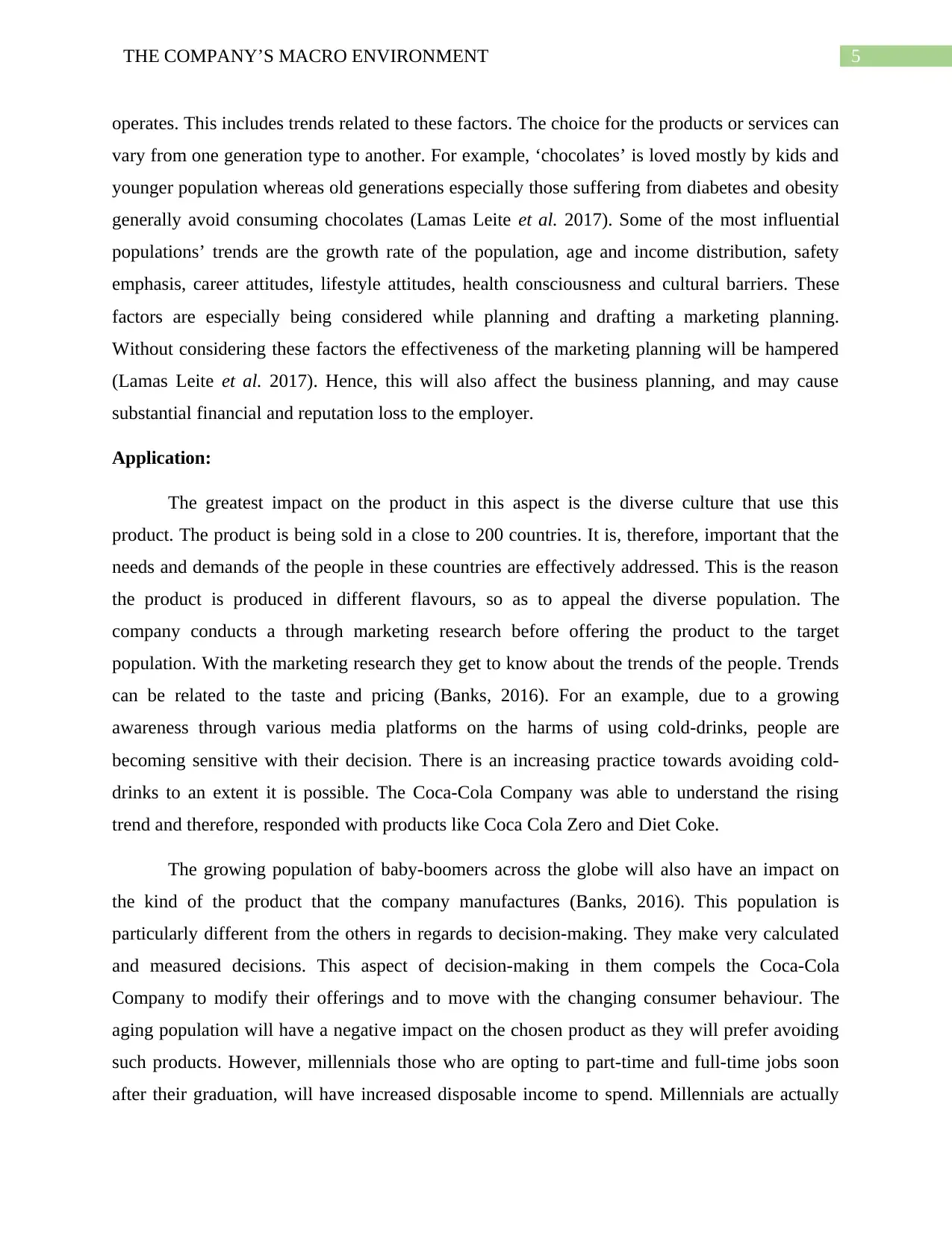
5THE COMPANY’S MACRO ENVIRONMENT
operates. This includes trends related to these factors. The choice for the products or services can
vary from one generation type to another. For example, ‘chocolates’ is loved mostly by kids and
younger population whereas old generations especially those suffering from diabetes and obesity
generally avoid consuming chocolates (Lamas Leite et al. 2017). Some of the most influential
populations’ trends are the growth rate of the population, age and income distribution, safety
emphasis, career attitudes, lifestyle attitudes, health consciousness and cultural barriers. These
factors are especially being considered while planning and drafting a marketing planning.
Without considering these factors the effectiveness of the marketing planning will be hampered
(Lamas Leite et al. 2017). Hence, this will also affect the business planning, and may cause
substantial financial and reputation loss to the employer.
Application:
The greatest impact on the product in this aspect is the diverse culture that use this
product. The product is being sold in a close to 200 countries. It is, therefore, important that the
needs and demands of the people in these countries are effectively addressed. This is the reason
the product is produced in different flavours, so as to appeal the diverse population. The
company conducts a through marketing research before offering the product to the target
population. With the marketing research they get to know about the trends of the people. Trends
can be related to the taste and pricing (Banks, 2016). For an example, due to a growing
awareness through various media platforms on the harms of using cold-drinks, people are
becoming sensitive with their decision. There is an increasing practice towards avoiding cold-
drinks to an extent it is possible. The Coca-Cola Company was able to understand the rising
trend and therefore, responded with products like Coca Cola Zero and Diet Coke.
The growing population of baby-boomers across the globe will also have an impact on
the kind of the product that the company manufactures (Banks, 2016). This population is
particularly different from the others in regards to decision-making. They make very calculated
and measured decisions. This aspect of decision-making in them compels the Coca-Cola
Company to modify their offerings and to move with the changing consumer behaviour. The
aging population will have a negative impact on the chosen product as they will prefer avoiding
such products. However, millennials those who are opting to part-time and full-time jobs soon
after their graduation, will have increased disposable income to spend. Millennials are actually
operates. This includes trends related to these factors. The choice for the products or services can
vary from one generation type to another. For example, ‘chocolates’ is loved mostly by kids and
younger population whereas old generations especially those suffering from diabetes and obesity
generally avoid consuming chocolates (Lamas Leite et al. 2017). Some of the most influential
populations’ trends are the growth rate of the population, age and income distribution, safety
emphasis, career attitudes, lifestyle attitudes, health consciousness and cultural barriers. These
factors are especially being considered while planning and drafting a marketing planning.
Without considering these factors the effectiveness of the marketing planning will be hampered
(Lamas Leite et al. 2017). Hence, this will also affect the business planning, and may cause
substantial financial and reputation loss to the employer.
Application:
The greatest impact on the product in this aspect is the diverse culture that use this
product. The product is being sold in a close to 200 countries. It is, therefore, important that the
needs and demands of the people in these countries are effectively addressed. This is the reason
the product is produced in different flavours, so as to appeal the diverse population. The
company conducts a through marketing research before offering the product to the target
population. With the marketing research they get to know about the trends of the people. Trends
can be related to the taste and pricing (Banks, 2016). For an example, due to a growing
awareness through various media platforms on the harms of using cold-drinks, people are
becoming sensitive with their decision. There is an increasing practice towards avoiding cold-
drinks to an extent it is possible. The Coca-Cola Company was able to understand the rising
trend and therefore, responded with products like Coca Cola Zero and Diet Coke.
The growing population of baby-boomers across the globe will also have an impact on
the kind of the product that the company manufactures (Banks, 2016). This population is
particularly different from the others in regards to decision-making. They make very calculated
and measured decisions. This aspect of decision-making in them compels the Coca-Cola
Company to modify their offerings and to move with the changing consumer behaviour. The
aging population will have a negative impact on the chosen product as they will prefer avoiding
such products. However, millennials those who are opting to part-time and full-time jobs soon
after their graduation, will have increased disposable income to spend. Millennials are actually
⊘ This is a preview!⊘
Do you want full access?
Subscribe today to unlock all pages.

Trusted by 1+ million students worldwide
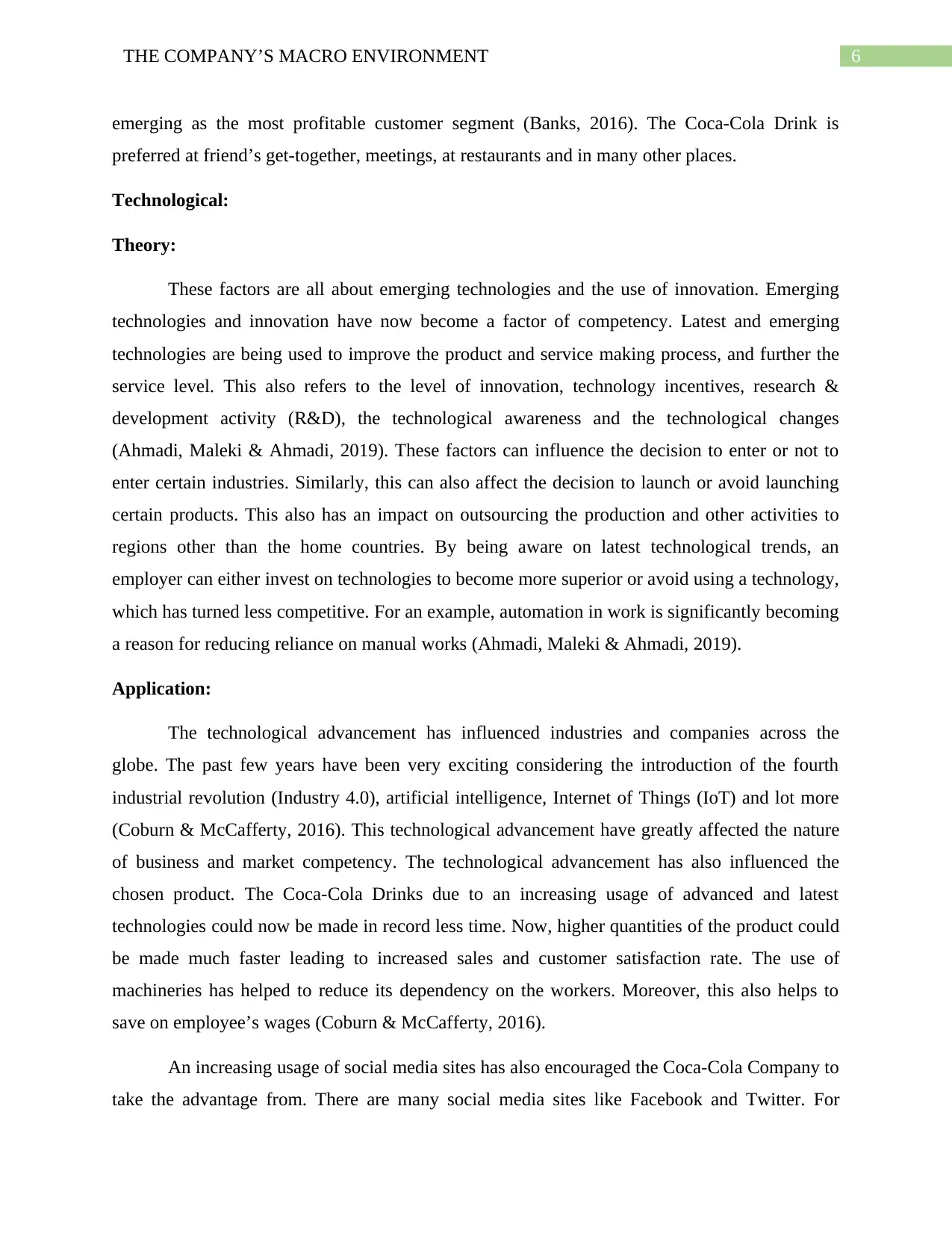
6THE COMPANY’S MACRO ENVIRONMENT
emerging as the most profitable customer segment (Banks, 2016). The Coca-Cola Drink is
preferred at friend’s get-together, meetings, at restaurants and in many other places.
Technological:
Theory:
These factors are all about emerging technologies and the use of innovation. Emerging
technologies and innovation have now become a factor of competency. Latest and emerging
technologies are being used to improve the product and service making process, and further the
service level. This also refers to the level of innovation, technology incentives, research &
development activity (R&D), the technological awareness and the technological changes
(Ahmadi, Maleki & Ahmadi, 2019). These factors can influence the decision to enter or not to
enter certain industries. Similarly, this can also affect the decision to launch or avoid launching
certain products. This also has an impact on outsourcing the production and other activities to
regions other than the home countries. By being aware on latest technological trends, an
employer can either invest on technologies to become more superior or avoid using a technology,
which has turned less competitive. For an example, automation in work is significantly becoming
a reason for reducing reliance on manual works (Ahmadi, Maleki & Ahmadi, 2019).
Application:
The technological advancement has influenced industries and companies across the
globe. The past few years have been very exciting considering the introduction of the fourth
industrial revolution (Industry 4.0), artificial intelligence, Internet of Things (IoT) and lot more
(Coburn & McCafferty, 2016). This technological advancement have greatly affected the nature
of business and market competency. The technological advancement has also influenced the
chosen product. The Coca-Cola Drinks due to an increasing usage of advanced and latest
technologies could now be made in record less time. Now, higher quantities of the product could
be made much faster leading to increased sales and customer satisfaction rate. The use of
machineries has helped to reduce its dependency on the workers. Moreover, this also helps to
save on employee’s wages (Coburn & McCafferty, 2016).
An increasing usage of social media sites has also encouraged the Coca-Cola Company to
take the advantage from. There are many social media sites like Facebook and Twitter. For
emerging as the most profitable customer segment (Banks, 2016). The Coca-Cola Drink is
preferred at friend’s get-together, meetings, at restaurants and in many other places.
Technological:
Theory:
These factors are all about emerging technologies and the use of innovation. Emerging
technologies and innovation have now become a factor of competency. Latest and emerging
technologies are being used to improve the product and service making process, and further the
service level. This also refers to the level of innovation, technology incentives, research &
development activity (R&D), the technological awareness and the technological changes
(Ahmadi, Maleki & Ahmadi, 2019). These factors can influence the decision to enter or not to
enter certain industries. Similarly, this can also affect the decision to launch or avoid launching
certain products. This also has an impact on outsourcing the production and other activities to
regions other than the home countries. By being aware on latest technological trends, an
employer can either invest on technologies to become more superior or avoid using a technology,
which has turned less competitive. For an example, automation in work is significantly becoming
a reason for reducing reliance on manual works (Ahmadi, Maleki & Ahmadi, 2019).
Application:
The technological advancement has influenced industries and companies across the
globe. The past few years have been very exciting considering the introduction of the fourth
industrial revolution (Industry 4.0), artificial intelligence, Internet of Things (IoT) and lot more
(Coburn & McCafferty, 2016). This technological advancement have greatly affected the nature
of business and market competency. The technological advancement has also influenced the
chosen product. The Coca-Cola Drinks due to an increasing usage of advanced and latest
technologies could now be made in record less time. Now, higher quantities of the product could
be made much faster leading to increased sales and customer satisfaction rate. The use of
machineries has helped to reduce its dependency on the workers. Moreover, this also helps to
save on employee’s wages (Coburn & McCafferty, 2016).
An increasing usage of social media sites has also encouraged the Coca-Cola Company to
take the advantage from. There are many social media sites like Facebook and Twitter. For
Paraphrase This Document
Need a fresh take? Get an instant paraphrase of this document with our AI Paraphraser
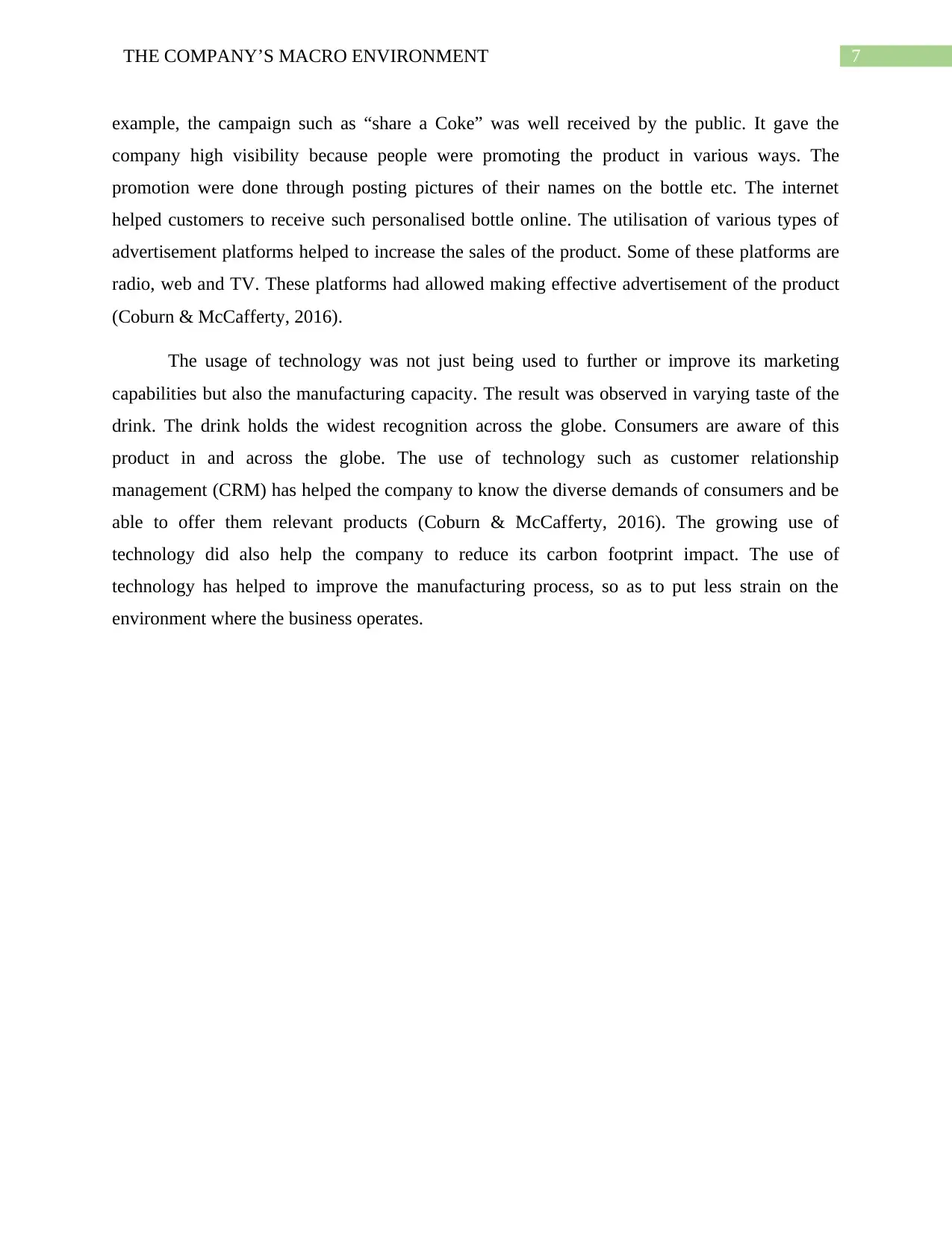
7THE COMPANY’S MACRO ENVIRONMENT
example, the campaign such as “share a Coke” was well received by the public. It gave the
company high visibility because people were promoting the product in various ways. The
promotion were done through posting pictures of their names on the bottle etc. The internet
helped customers to receive such personalised bottle online. The utilisation of various types of
advertisement platforms helped to increase the sales of the product. Some of these platforms are
radio, web and TV. These platforms had allowed making effective advertisement of the product
(Coburn & McCafferty, 2016).
The usage of technology was not just being used to further or improve its marketing
capabilities but also the manufacturing capacity. The result was observed in varying taste of the
drink. The drink holds the widest recognition across the globe. Consumers are aware of this
product in and across the globe. The use of technology such as customer relationship
management (CRM) has helped the company to know the diverse demands of consumers and be
able to offer them relevant products (Coburn & McCafferty, 2016). The growing use of
technology did also help the company to reduce its carbon footprint impact. The use of
technology has helped to improve the manufacturing process, so as to put less strain on the
environment where the business operates.
example, the campaign such as “share a Coke” was well received by the public. It gave the
company high visibility because people were promoting the product in various ways. The
promotion were done through posting pictures of their names on the bottle etc. The internet
helped customers to receive such personalised bottle online. The utilisation of various types of
advertisement platforms helped to increase the sales of the product. Some of these platforms are
radio, web and TV. These platforms had allowed making effective advertisement of the product
(Coburn & McCafferty, 2016).
The usage of technology was not just being used to further or improve its marketing
capabilities but also the manufacturing capacity. The result was observed in varying taste of the
drink. The drink holds the widest recognition across the globe. Consumers are aware of this
product in and across the globe. The use of technology such as customer relationship
management (CRM) has helped the company to know the diverse demands of consumers and be
able to offer them relevant products (Coburn & McCafferty, 2016). The growing use of
technology did also help the company to reduce its carbon footprint impact. The use of
technology has helped to improve the manufacturing process, so as to put less strain on the
environment where the business operates.
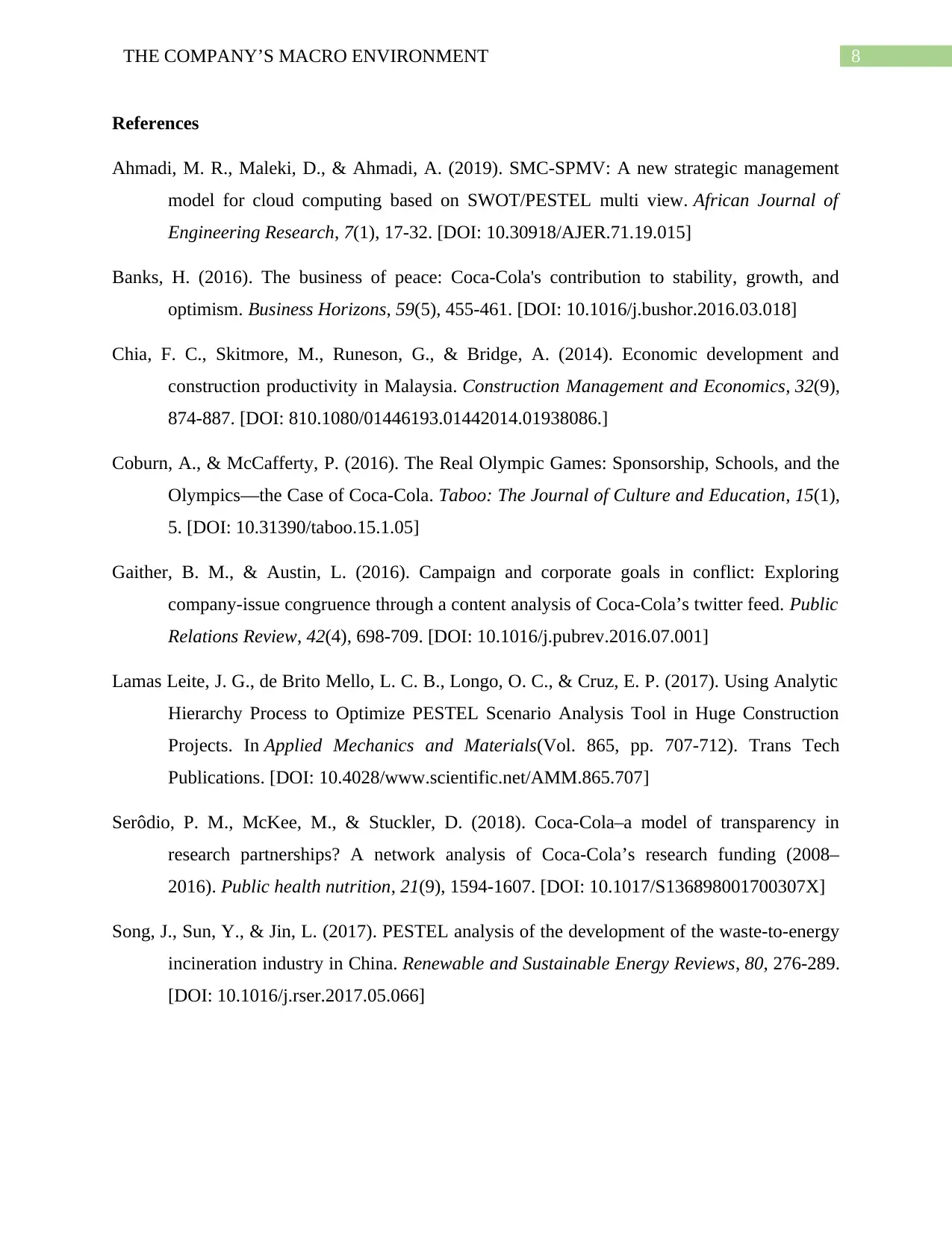
8THE COMPANY’S MACRO ENVIRONMENT
References
Ahmadi, M. R., Maleki, D., & Ahmadi, A. (2019). SMC-SPMV: A new strategic management
model for cloud computing based on SWOT/PESTEL multi view. African Journal of
Engineering Research, 7(1), 17-32. [DOI: 10.30918/AJER.71.19.015]
Banks, H. (2016). The business of peace: Coca-Cola's contribution to stability, growth, and
optimism. Business Horizons, 59(5), 455-461. [DOI: 10.1016/j.bushor.2016.03.018]
Chia, F. C., Skitmore, M., Runeson, G., & Bridge, A. (2014). Economic development and
construction productivity in Malaysia. Construction Management and Economics, 32(9),
874-887. [DOI: 810.1080/01446193.01442014.01938086.]
Coburn, A., & McCafferty, P. (2016). The Real Olympic Games: Sponsorship, Schools, and the
Olympics—the Case of Coca-Cola. Taboo: The Journal of Culture and Education, 15(1),
5. [DOI: 10.31390/taboo.15.1.05]
Gaither, B. M., & Austin, L. (2016). Campaign and corporate goals in conflict: Exploring
company-issue congruence through a content analysis of Coca-Cola’s twitter feed. Public
Relations Review, 42(4), 698-709. [DOI: 10.1016/j.pubrev.2016.07.001]
Lamas Leite, J. G., de Brito Mello, L. C. B., Longo, O. C., & Cruz, E. P. (2017). Using Analytic
Hierarchy Process to Optimize PESTEL Scenario Analysis Tool in Huge Construction
Projects. In Applied Mechanics and Materials(Vol. 865, pp. 707-712). Trans Tech
Publications. [DOI: 10.4028/www.scientific.net/AMM.865.707]
Serôdio, P. M., McKee, M., & Stuckler, D. (2018). Coca-Cola–a model of transparency in
research partnerships? A network analysis of Coca-Cola’s research funding (2008–
2016). Public health nutrition, 21(9), 1594-1607. [DOI: 10.1017/S136898001700307X]
Song, J., Sun, Y., & Jin, L. (2017). PESTEL analysis of the development of the waste-to-energy
incineration industry in China. Renewable and Sustainable Energy Reviews, 80, 276-289.
[DOI: 10.1016/j.rser.2017.05.066]
References
Ahmadi, M. R., Maleki, D., & Ahmadi, A. (2019). SMC-SPMV: A new strategic management
model for cloud computing based on SWOT/PESTEL multi view. African Journal of
Engineering Research, 7(1), 17-32. [DOI: 10.30918/AJER.71.19.015]
Banks, H. (2016). The business of peace: Coca-Cola's contribution to stability, growth, and
optimism. Business Horizons, 59(5), 455-461. [DOI: 10.1016/j.bushor.2016.03.018]
Chia, F. C., Skitmore, M., Runeson, G., & Bridge, A. (2014). Economic development and
construction productivity in Malaysia. Construction Management and Economics, 32(9),
874-887. [DOI: 810.1080/01446193.01442014.01938086.]
Coburn, A., & McCafferty, P. (2016). The Real Olympic Games: Sponsorship, Schools, and the
Olympics—the Case of Coca-Cola. Taboo: The Journal of Culture and Education, 15(1),
5. [DOI: 10.31390/taboo.15.1.05]
Gaither, B. M., & Austin, L. (2016). Campaign and corporate goals in conflict: Exploring
company-issue congruence through a content analysis of Coca-Cola’s twitter feed. Public
Relations Review, 42(4), 698-709. [DOI: 10.1016/j.pubrev.2016.07.001]
Lamas Leite, J. G., de Brito Mello, L. C. B., Longo, O. C., & Cruz, E. P. (2017). Using Analytic
Hierarchy Process to Optimize PESTEL Scenario Analysis Tool in Huge Construction
Projects. In Applied Mechanics and Materials(Vol. 865, pp. 707-712). Trans Tech
Publications. [DOI: 10.4028/www.scientific.net/AMM.865.707]
Serôdio, P. M., McKee, M., & Stuckler, D. (2018). Coca-Cola–a model of transparency in
research partnerships? A network analysis of Coca-Cola’s research funding (2008–
2016). Public health nutrition, 21(9), 1594-1607. [DOI: 10.1017/S136898001700307X]
Song, J., Sun, Y., & Jin, L. (2017). PESTEL analysis of the development of the waste-to-energy
incineration industry in China. Renewable and Sustainable Energy Reviews, 80, 276-289.
[DOI: 10.1016/j.rser.2017.05.066]
⊘ This is a preview!⊘
Do you want full access?
Subscribe today to unlock all pages.

Trusted by 1+ million students worldwide
1 out of 9
Related Documents
Your All-in-One AI-Powered Toolkit for Academic Success.
+13062052269
info@desklib.com
Available 24*7 on WhatsApp / Email
![[object Object]](/_next/static/media/star-bottom.7253800d.svg)
Unlock your academic potential
Copyright © 2020–2025 A2Z Services. All Rights Reserved. Developed and managed by ZUCOL.



